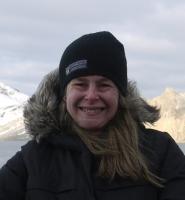De los Ríos Asunción
- Investigadora Científica
- Departamento: Biogeoquímica y Ecología Microbiana
- Dirección física: ICA, Serrano 115 dpdo
- Teléfono: 620394180
- Email: arios@mncn.csic.es
- Número ORCID: 0000-0002-0266-3516
- Palabras clave:

Investigación
Mi carrera investigadora ha estado hasta ahora centrada en la caracterización de la diversidad, organización espacial y funcionamiento de ecosistemas microbianos terrestres, especialmente de aquellos que se localizan en ambientes extremos y que se desarrollan en asociación con el sustrato lítico.
Proyectos en curso
Biometeorización de rocas y procesos de formación de suelos en la zona crítica polar: aproximación multiescalar
Agencia estatal de Investigación. Ministerio de Ciencia e Innovación
2020-2024
Investigador principal
Metabolic processes and trophic interactions in antarctic cryptoendolithic communities
FICUS Project (JGI & EMSL)
2021
IPs (Laura Selbmann, University de la Tuscia; Jason Stajish, University of California Riverside; Asuncion de los Ríos, MNCN-CSIC)
Biodiversity, three-dimensional organization, ecosystem functioning and interdependencies in cryptogamic covers of arid and polar regions-
Ministerio de Economía y Competitividad
2016-2020
Investigador Principal

Biodiversity and pairing of algal partners with lichen-forming fungi in leaf-deweling lichen communities in Florida and Spain
Florida Gulf Coast University-Research Ventura Capital Fund
2019
Investigador

Red Nacional de microorganismos extremófilos.
Ministerio de Ciencia, innovación y Universidades
2023-2024
Investigador

Tecnologías en Ciencias del Patrimonio. Top-Heritage-CM.
Programa de actividades de I+D entre grupos de investigación de la Comunidad de Madrid
Enero 2019-Diciembre 2022.
Investigador principal de Grupo
-

Publicaciones relevantes
Ultimos 10 años, una lista completa de publicaciones puede encontrase en Google scholar;
-
-
-
Pérez-Ortega S., Verdú M., Garrido_Benavent I., Rabasa S., Green TG A, Sancho LG, de los Ríos A. (2023) Invariant properties of mycobiont‐photobiont networks in Antarctic lichens. Global Ecology and Biogeography.
-
-
Villar de Pablo M., Ascaso C., Rodríguez-Pérez E., Urizal M., Wierzchos J., Pérez-Ortega S., de los Ríos A. (2023) Innovative approaches to accurately assess the effectiveness of biocide-based treatments to fight biodeterioration of Cultural Heritage monuments. The Science of the total environment. DOI: 10.1016/j.scitotenv.2023.165318
-
-
Garrido-Benavent., de los Ríos A., Nuñez-Zapata J., Ortiz-Alvarez R., Schultz M., Pérez-Ortega S. (2023) Ocean crossers: A tale of disjunctions and speciation in the dwarf-fruticose Lichina (lichenized Ascomycota). Molecular Phylogenetics and Evolution. DOI: 10.1016/j.ympev.2023.107829
-
-
Eldridge DJ et al. (2023) The global contribution of soil mosses to ecosystem services. Nature Geoscience 16(5)
-
-
Ortiz-Rivero J., Garrido-Benavent I., Heimarsson S., De los Ríos A. (2023) Moss and Liverwort Covers Structure Soil Bacterial and Fungal Communities Differently in the Icelandic Highlands. Microbial Ecology
-
-
De los Ríos, A., Garrido-Benavent, I., Limón, A., Cowan D., Valverde A. (2022) Novel lichen-dominated hypolithic communities in the Namib Desert. Microbial Ecology 83(4):1-13
-
-
-
-
-
-
Nir I., Barak H., Kramarsky-Winter E., Kushmaro A., de los Ríos A. (2021) Microscopic and biomolecular complementary approaches to characterize bioweathering processes at petroglyph sites from the Negev Desert, Israel. Environmental Microbiology
-
-
Durán, J., Rodríguez, A., Fangueiro, D., de los Ríos, A. (2021) In-situ soil greenhouse gas fluxes under different cryptogamic covers in maritime Antarctica. Science of The Total Environment 770: 144557.
-
-
Del Moral, A., Garrido-Benavent, I., Durán, J., Lehmann., J.R., Rodríguez, A., Heiðmarsson, S., de los Ríos, A. (2021) Are recently deglaciated áreas at both poles colonised by the same bacteria? FEMS Microbiology Letters 368: fnab011.
-
-
-
-
-
Coleine C, Stajich J, de los Ríos A, Selbmann L (2020) Beyond the extremes: Rocks as ultimate refuge for fungi in drylands. Mycologia
-
Garrido-Benavent I., Pérez_Ortega S., Durán J., Ascaso C., Pointing S.B., Rodríguez-Cielos R., Navarro F., de los Ríos A. (2020) Differential Colonization and Succession of Microbial Communities in Rock and Soil Substrates on a Maritime Antarctic Glacier Forefield. Frontiers in Microbiology
-
-
-
Durán J, Rodríguez A., Heiðmarsson S, Lehmann JRK, Del Moral A.,Garrido-Benavent I., de los Ríos A. (2020) Cryptogamic cover determines soil attributes and functioning in polar terrestrial ecosystems. Science of The Total Environment, 143169.
-
-
-
- Tornos F., Oggerin M., de los Ríos A., Rodríguez N., Amils R., Sanz JL, Rojas P., Velasco F., Escobar JM, Gómez C., Slack JF. (2019) Do microbes control the formation of giant copper deposits?. Geology 47: 143-146.
-
- Ortiz-Alvárez R., Fierer N., de los Ríos A., Casamayor E.O., Barberán A. (2018) Consistent changes in the taxonomic structure and functional attributes of bacterial communities during primary succession. ISME Journal DOI:10.1038/s41396-018-0076-2·
-
- Garrido-Benavent I., De los Ríos A., Fernández-Mendoza F., Pérez-Ortega S. (2017) No need for stepping stones: dircet joint dispersal of the lichen-forming fungus Mastodia tesellata (Ascomycota) and its photobiont explains their bipolar distribution. Journal of Biogeography DOI: 10.1111/jbi.13105.
-
- Sanders, W., de los Ríos A. (2017) Parenchymatous cell division characterizes the fungal cortex of some common foliose lichens. American Journal of Botany 104: 207-217.
-
- Garrido-Benavent I., Pérez-Ortega S., de los Ríos A. (2017) From Alaska to Antarctica: Species boundaries and genetic diversity of Prasiola (Trebouxiophyceae), a foliose chlorophyte associated with the bipolar lichen-forming fungus Mastodia tessellata. Molecular Phylogenetics and Evolution 107: 117 – 131.
-
- Hinchcliffe G., Bollard-Breen B., Cowan DA, Doshi A., Gillman L., Maggs-Colling G., de los Ríos A., Pointing S.B. (2017) Advanced Photogrammetry to Assess Lichen Colonization in the Hyper-Arid Namib Desert. Frontiers in Microbiology 8, DOI: 10.3389/fmicb.2017.02083.
-
- Lacap-Bugler D.C., Lee K.K., Archer S., Gillman L.N., Lau M.C.Y., Leuzinger S., Lee C.K., Maki T., McKay C.P., Perrott J.K., de los Ríos A., Warren-Rhodes K.A., Hopkins D.W., Pointing S.B. (2017) Global diversity of desert hypolithic cyanobacteria. Frontiers in Microbiology 16 https://doi.org/10.3389/fmicb.2017.00867
-
- Fernández-Martínez M.A., Pérez-Ortega S., Pointing S.B., Green TGA, Pintado A., Rozzi R., Sancho L.G., de los Ríos A. (2017) Microbial succession dynamics along glacier forefield chronosequences in Tierra del Fuego (Chile). Polar Biology 40: 1939-1957.
-
- Pérez-Ortega S., Garrido-Benavent I., Grube M., Olmo R., de los Ríos A. (2016) Hidden diversity of marine borderline lichens and a new order of fungi: Collemopsidiales (Dothideomyceta). Fungal diversity. DOI 10.1007/s13225-016-0361-1
-
- Velázquez D., López-Bueno A., Aguirre de Cárcer D., de los Ríos A., Alcami A., Quesada A. (2016) Ecosystem function decays by fungal outbreaks in Antarctic microbial mats. Scientific Reports, DOI: 10.1038/srep22954.
-
- Sanders W.B., Pérez-Ortega S., Nelsen M.P., Lücking R., de los Ríos A. (2016) Heveochlorella (Trebouxiophyceae): a little-known genus of unicellular green algae outside the Trebouxiales emerges unexpectedly as a major clade of lichen photobionts in foliicolous communities. Journal of Phycology 52: 840–853.
-
- De los Ríos A., Wierzchos J, Ascaso C., Vincent W., Quesada A. (2015) Microstructure and cyanobacterial composition of microbial mats from the High Arctic. Biodiversity and Conservation 24, 841–863.
-
- De los Ríos A., Wierzchos J, Ascaso C. (2014) The lithic microbial ecosystems of Antarctica’s McMurdo Dry Valleys. Antarctic Science 26: 459–477.
-
- De los Ríos A., Cary C., Cowan D. (2014) The spatial structures of hypolithic communities in the Dry Valleys of East Antarctica.Polar Biology 37: 1823–1833
-
- Pérez-Ortega S., Suija A., Crespo A., de los Ríos A. (2014) Lichenicolous fungi of the genus Abrothallus (Dothideomycetes: Abrothallales ordo nov.) are sister to the predominantly aquatic Janhulales. Fungal Diversity 64: 295-304.
-
- De los Ríos A., Pérez-Ortega S., Wierzchos J., Ascaso C. (2012) Differential effects of biocide treatments on saxicolous communities: case study of the Segovia Cathedral Cloister (Spain). International Biodeterioration and Biodegradation 67: 64-72.
-
- Pérez-Ortega S., Green T.G.A., Ortiz R., de los Ríos, A. (2012) Myco- and photobiont diversity and their relationships at the edge of life (McMurdo Dry Valleys, Antarctica). FEMS Microbiology Ecology 82: 429-448.
-
- De los Ríos A., Pérez-Ortega S., Wierzchos J., Ascaso C. (2012) Differential effects of biocide treatments on saxicolous communities: case study of the Segovia Cathedral Cloister (Spain). International Biodeterioration and Biodegradation 67: 64-72.
-
- Pérez-Ortega S., Suija A., Crespo A., de los Ríos A. (2014) Lichenicolous fungi of the genus Abrothallus (Dothideomycetes: Abrothallales ordo nov.) are sister to the predominantly aquatic Janhulales. Fungal Diversity 64: 295-304.
-
- De los Ríos A., Cary C., Cowan D. (2014) The spatial structures of hypolithic communities in the Dry Valleys of East Antarctica.Polar Biology 37: 1823–1833
-
- De los Ríos A., Wierzchos J, Ascaso C. (2014) The lithic microbial ecosystems of Antarctica’s McMurdo Dry Valleys. Antarctic Science 26: 459–477.
-
- De los Ríos A., Wierzchos J, Ascaso C., Vincent W., Quesada A. (2015) Microstructure and cyanobacterial composition of microbial mats from the High Arctic. Biodiversity and Conservation 24, 841–863.
-
- Sanders W.B., Pérez-Ortega S., Nelsen M.P., Lücking R., de los Ríos A. (2016) Heveochlorella (Trebouxiophyceae): a little-known genus of unicellular green algae outside the Trebouxiales emerges unexpectedly as a major clade of lichen photobionts in foliicolous communities. Journal of Phycology 52: 840–853.
-
- Velázquez D., López-Bueno A., Aguirre de Cárcer D., de los Ríos A., Alcami A., Quesada A. (2016) Ecosystem function decays by fungal outbreaks in Antarctic microbial mats. Scientific Reports, DOI: 10.1038/srep22954.
-
- Pérez-Ortega S., Garrido-Benavent I., Grube M., Olmo R., de los Ríos A. (2016) Hidden diversity of marine borderline lichens and a new order of fungi: Collemopsidiales (Dothideomyceta). Fungal diversity. DOI 10.1007/s13225-016-0361-1
-
- Fernández-Martínez M.A., Pérez-Ortega S., Pointing S.B., Green TGA, Pintado A., Rozzi R., Sancho L.G., de los Ríos A. (2017) Microbial succession dynamics along glacier forefield chronosequences in Tierra del Fuego (Chile). Polar Biology 40: 1939-1957.
-
- Lacap-Bugler D.C., Lee K.K., Archer S., Gillman L.N., Lau M.C.Y., Leuzinger S., Lee C.K., Maki T., McKay C.P., Perrott J.K., de los Ríos A., Warren-Rhodes K.A., Hopkins D.W., Pointing S.B. (2017) Global diversity of desert hypolithic cyanobacteria. Frontiers in Microbiology 16 https://doi.org/10.3389/fmicb.2017.00867
-
- Hinchcliffe G., Bollard-Breen B., Cowan DA, Doshi A., Gillman L., Maggs-Colling G., de los Ríos A., Pointing S.B. (2017) Advanced Photogrammetry to Assess Lichen Colonization in the Hyper-Arid Namib Desert. Frontiers in Microbiology 8, DOI: 10.3389/fmicb.2017.02083.
-
- Garrido-Benavent I., Pérez-Ortega S., de los Ríos A. (2017) From Alaska to Antarctica: Species boundaries and genetic diversity of Prasiola (Trebouxiophyceae), a foliose chlorophyte associated with the bipolar lichen-forming fungus Mastodia tessellata. Molecular Phylogenetics and Evolution 107: 117 – 131.
-
- Sanders, W., de los Ríos A. (2017) Parenchymatous cell division characterizes the fungal cortex of some common foliose lichens. American Journal of Botany 104: 207-217.
-
- Garrido-Benavent I., De los Ríos A., Fernández-Mendoza F., Pérez-Ortega S. (2017) No need for stepping stones: dircet joint dispersal of the lichen-forming fungus Mastodia tesellata (Ascomycota) and its photobiont explains their bipolar distribution. Journal of Biogeography DOI: 10.1111/jbi.13105.
-
- Ortiz-Alvárez R., Fierer N., de los Ríos A., Casamayor E.O., Barberán A. (2018) Consistent changes in the taxonomic structure and functional attributes of bacterial communities during primary succession. ISME Journal DOI:10.1038/s41396-018-0076-2·
-
-
-







